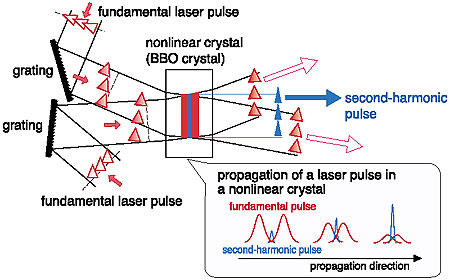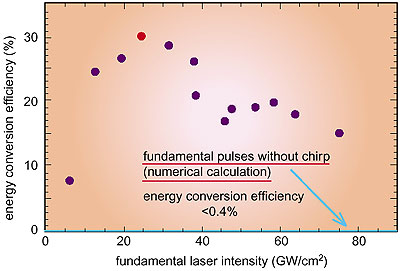A 100 TW Ti: sapphire laser which has been developed at JAERI produces ultrashort laser pulses of less than 20 fs duration at about 800 nm. We are attempting to convert the wavelengths of such pulses into shorter values. Our hope is that a shorter wavelength laser, i.e., one having larger photon energy, will bring rapid progress in developing X-ray lasers and in research on the interaction of laser radiation with plasmas.
Laser wavelength (or frequency) conversion is typically made by means of a second-(or higher order) harmonic generation scheme using nonlinear optical crystals such as KH2PO4 (KDP) and BaB2O4 (BBO). This technique is well established for lasers having a uniform frequency. Frequencies of short laser pulses, however, inevitably have a broad distribution. Consequently, adjusting them in a frequency-doubling scheme is difficult.
Our solution involves dispersing the input pulse by means of optical gratings so that each frequency component enters the nonlinear crystal at the appropriate angle to give optimal phase matching (Fig. 8-1). Two fundamental pulses are incident on the nonlinear crystal at angles adjusted so that their pulse wave fronts may propagate in the crystal. On superposition in the crystal, they generate a second-harmonic pulse. Moreover, self-compression of the second-harmonic pulse so generated can also be accomplished by adjusting the incidence angles of the fundamental pulses.
In the preliminary experiments where an efficiency of 0.4% was expected, 30% efficiency was achieved (Fig. 8-2). Under proper conditions, as high as 70% is found to be possible. |


